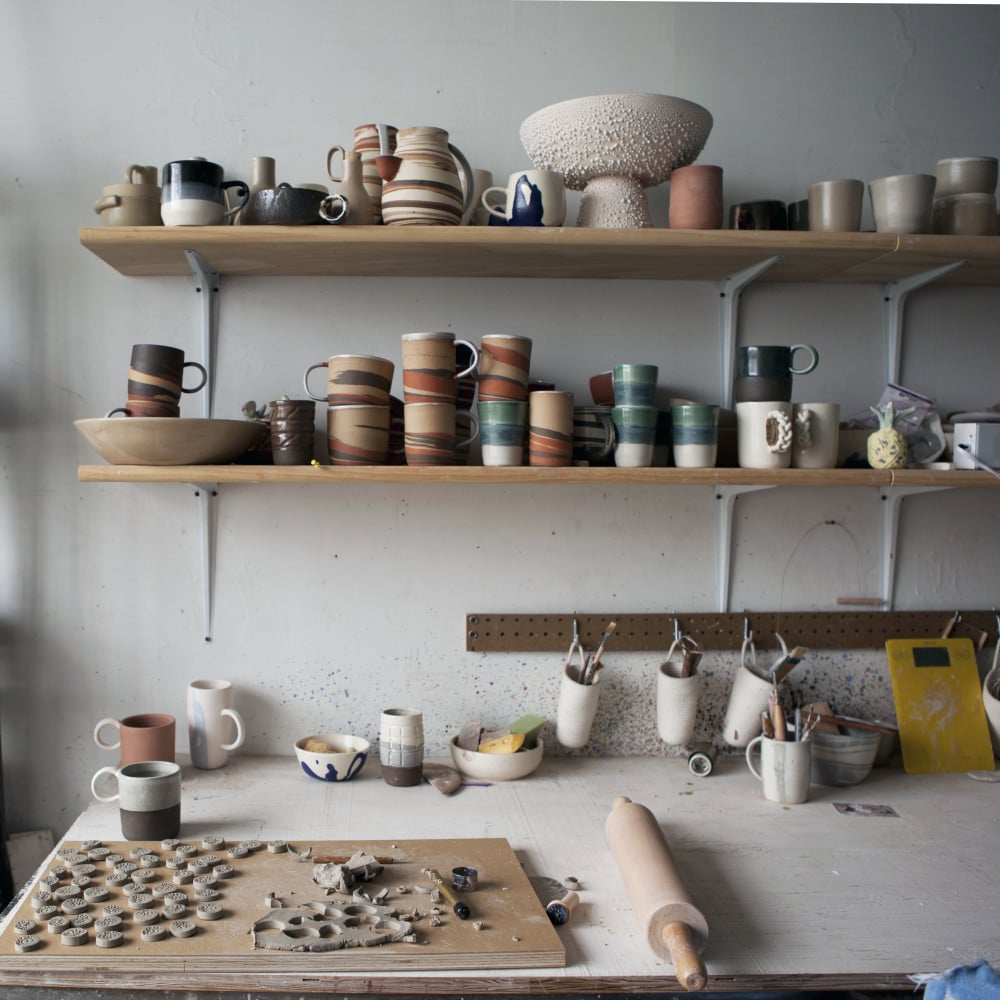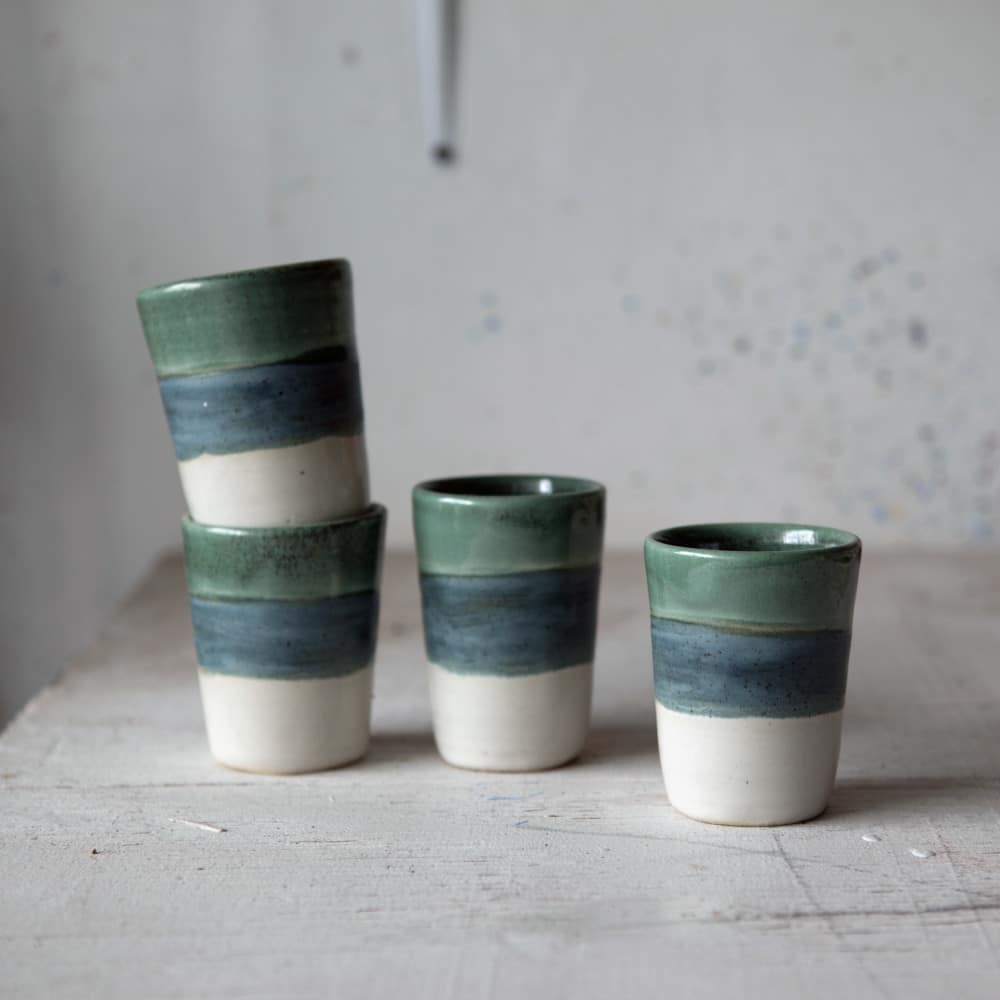Helen Levi es una neoyorquina que pasó de hacer malabarismos con cuatro trabajos a la vez a convertirse en una potencia del arte cerámico en tan sólo unos años. Después de que le pidieran que hiciera algunas piezas para venderlas en la tienda boutique de Steven Alan, decidió dar el salto, abandonar los trabajos secundarios y dedicarse a tiempo completo a su oficio y a su negocio.
Desde ese momento crucial, Levi ha realizado grandes pedidos de vajillas artesanales para restaurantes, ha aparecido en casi todas las listas de "los mejores artistas cerámicos" y ha conseguido un impresionante 128k de seguidores de Instagram. La ocupada artista y empresaria de Brooklyn se tomó un tiempo para contarnos lo que ha aprendido sobre la gestión de un negocio creativo.
Vendí mi primera pieza cuando conocí a Steven Alan en una tienda pop-up. Después de charlar un poco, me pidió que le enviara algunas fotos de mi trabajo. Nunca antes había fotografiado mi trabajo porque siempre había sido sólo un hobby. Pero en cuanto establecí esa conexión, me entusiasmó la idea de hacer de ese hobby un trabajo, y puse todo mi empeño en que funcionara.
El momento de esa decisión probablemente tuvo algo que ver con la popularidad actual de cerámica artesanal. Creo que está ligado a la tendencia general de comprar con conciencia a mayor escala: la gente se preocupa por la procedencia de sus alimentos, quiere comprar ropa fabricada éticamente, quiere cocinar con carne de origen ético. En mi opinión, esto se traslada a los objetos que utilizamos en casa. La gente parece tener más curiosidad por establecer una conexión con todos los objetos de los que se rodea, ya sea un jersey o una taza. Obviamente, es mucho más caro comprar objetos hechos a mano, por lo que no está al alcance de todas las personas.
Estaba muy agradecida por tener por fin la continuidad de un solo trabajo. Siempre me costó encontrar el equilibrio entre los distintos compromisos a tiempo parcial que tenía. Ahora me siento bien en el sentido de que mi trabajo me apoya y me encanta lo que hago, pero ha sido un crecimiento gradual, no hubo un momento concreto en el que todo encajara. Diría que en el último año he hecho un verdadero esfuerzo por tomarme uno o dos días libres a la semana, porque estaba en una fase en la que trabajaba tanto que olvidé lo importante que era un poco de tiempo libre.
Puesto que soy el único lanzador de ruedas en mi estudio Paso mucho tiempo al volante. Suelo hacer las tareas empresariales/informáticas por la mañana o por la noche y paso la mayor parte del día haciendo cosas. Para mí es muy importante mantener en primer plano las partes de mi trabajo que me aportan alegría.


Lo que más me gusta de mi trabajo es que tengo libertad para hacer lo que quiero, y puedo tomar esas decisiones por mí misma. Le digo a la gente que tengo una "empresa de cerámica" porque mi trabajo es funcional, y porque no soy estrictamente una artista. También soy responsable de la parte comercial. De estar al día con los correos electrónicos, las facturas, el papeleo, impuestos-¡Esas partes son las más difíciles para mí!
Aquel primer pedido grande fue una curva de aprendizaje muy dura. Aunque llevaba muchos años haciendo cerámica, nunca había tenido que hacer un pedido grande por ningún motivo, y aprendí rápidamente que el hecho de que hagas bien un prototipo no significa que si intentas hacer 25 iguales vayan a salir todos igual de bien.
Disfruto con el reto del trabajo a medida y de la colaboración. Me inspira y hace avanzar mi propio trabajo. Además, como negocio unipersonal, es agradable interactuar con otros diseñadores. Me mudé a mi propio estudio hace unos seis meses, pero antes tenía una pequeña habitación dentro del estudio de otro diseñador, Chen y Kai. Me encantó compartir con ellos porque trabajan con todo tipo de materiales diferentes: cemento, resina, madera, metal. Aunque sus negocios son muy diferentes, también hay mucho en común. Siempre podíamos hablar de negocios durante la comida.
Lo más difícil de Nueva York para mi línea de trabajo es el sector inmobiliario. Cuando este año firmé el contrato de arrendamiento de mi nuevo estudio en Red Hook, que es tres veces más grande que mi antiguo estudio, sentí miedo porque era el mayor compromiso que había contraído con mi negocio, pero también me sentí muy orgullosa. Tengo mucha suerte de haber encontrado mi estudio actual, pero nunca sientes que puedas contar con él más allá de tu contrato de alquiler actual.
Mi mejor consejo para otros alfareros sería mantén bajos tus gastos todo lo que puedas al principio, para que puedas centrarte en trabajar en tus diseños sin tanto estrés por el dinero. Cada "inversión" que he hecho en mi negocio ha sido relativamente pequeña. Empecé en un estudio comunitario donde el alquiler sólo costaba unos $250 al mes, y poco a poco fui subiendo hasta tener mi propio estudio.


Me ayudó mucho ser destacado por Instagram hace un par de años-me llevó a unos 20K seguidores y desde entonces ha sido un crecimiento lento y constante. Es una herramienta increíble para mi negocio, es con diferencia la mayor audiencia a la que puedo llegar. ¡Y es gratis! No cuesta nada tener una cuenta de Instagram.
Nunca sé lo que se venderá, siempre es una suposición. Intento seguir mi instinto y no pensar demasiado mis diseños. Me esfuerzo por ofrecer una gama de precios y estilos para intentar atraer a distintos tipos de clientes. Quiero que mis piezas se sitúen justo en medio de los dos extremos de ser supermínimas o superbrillantes y chillonas. Diría que la pieza a la que más cariño tengo es una taza que hice el año pasado durante una residencia en California. Tiene un rubor rosado de otra pieza que estaba cerca de ella en el horno de gas, que parece imposible de recrear.
Además de la naturaleza y de lo que me rodea, creo que me inspira mucho el proceso físico de la cerámica, de los distintos tipos de arcillas y materiales, y eso me da ideas para probar técnicas. Recomendaría a cualquiera que quiera probar la cerámica que tome unas cuantas clases con distintos profesores. Cada profesor de cerámica tiene un estilo diferente y una forma ligeramente distinta de hacer las cosas. Una vez que hayas visto algo de esa variedad, espero que te anime a encontrar tu propia voz.
La cerámica te enseña y te reta constantemente, lleves el tiempo que lleves haciéndola. Cometo pequeños errores todo el tiempo, pero no hay uno grande que me llame la atención. Sin embargo, lo bueno de un error es que probablemente no volverás a cometerlo. El colado es el proceso más reciente que he intentado aprender, empecé hace un año. Sigo recibiendo nuevos consejos y trucos para hacerlo mejor. Lo siguiente que me gustaría aprender es hacer trabajos más avanzados con losas.

Sigue a Helen Levi en Instagram @helen_levi y visita su portafolio online en helenlevi.com. (Imágenes de Factura del patio trasero)









